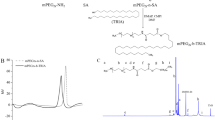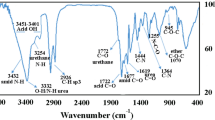Abstract
The purpose of this study is to develop an improved drug delivery system for enhanced paclitaxel (PTX) loading capacity and formulation stability based on PEG5K-(vitamin E)2 (PEG5K-VE2) system. PEG5K-(fluorenylmethoxycarbonyl)-(vitamin E)2 (PEG5K-FVE2) was synthesized using lysine as the scaffold. PTX-loaded PEG5K-FVE2 micelles were prepared and characterized. Fluorescence intensity of Fmoc in the micelles was measured as an indicator of drug-carrier interaction. Cytotoxicity of the micelle formulations was tested on various tumor cell lines. The therapeutic efficacy and toxicity of PTX-loaded micelles were investigated using a syngeneic mouse model of breast cancer (4T1.2). Our data suggest that the PEG5K-FVE2 micelles have a low CMC value of 4 μg/mL and small sizes (~60 nm). The PTX loading capacity of PEG5K-FVE2 micelles was much higher than that of PEG5K-VE2 micelles. The Fmoc/PTX physical interaction was clearly demonstrated by a fluorescence quenching assay. PTX-loaded PEG5K-FVE2 micelles exerted more potent cytotoxicity than free PTX or Taxol formulation in vitro. Finally, intravenous injection of PTX-loaded PEG5K-FVE2 micelles showed superior anticancer activity compared with PEG5K-VE2 formulation with minimal toxicity in a mouse model of breast cancer. In summary, incorporation of a drug-interactive motif (Fmoc) into PEG5K-VE2 micelles represents an effective strategy to improve the micelle formulation for the delivery of PTX.







Similar content being viewed by others

Abbreviations
- PTX:
-
Paclitaxel
- PEG5K-VE2 :
-
PEG5K-(vitamin E)2
- PEG5K-FVE2 :
-
PEG5K-(fluorenylmethoxycarbonyl)-(vitamin E)2
- EPR:
-
Enhanced permeability and retention
- TPGS:
-
d-alpha-tocopheryl polyethylene glycol (PEG)-1000 succinate
- CMC:
-
Critical micelle concentration
- DLS:
-
Dynamic light scattering
- DLC:
-
Drug loading capacity
- DLE:
-
Drug loading efficiency
- MTT:
-
3-(4,5-Dimethylthiazol-2-yl)-2,5-diphenyltetrazolium bromide
- AST:
-
Aspartate aminotransferase
- ALT:
-
Alanine aminotransferase
- PEI:
-
Polyethylenimine
References
Horwitz SB. Taxol (paclitaxel): mechanisms of action. Ann Oncol. 1994;5 Suppl 6:S3–6.
Soga O, van Nostrum CF, Fens M, Rijcken CJ, Schiffelers RM, Storm G, et al. Thermosensitive and biodegradable polymeric micelles for paclitaxel delivery. J Control Release. 2005;103:341–53.
Gao Z, Lukyanov AN, Singhal A, Torchilin VP. Diacyllipid-polymer micelles as nanocarriers for poorly soluble anticancer drugs. Nano Lett. 2002;2:979–82.
Kato K, Chin K, Yoshikawa T, Yamaguchi K, Tsuji Y, Esaki T, et al. Phase II study of NK105, a paclitaxel-incorporating micellar nanoparticle, for previously treated advanced or recurrent gastric cancer. Invest New Drugs. 2012;30:1621–7.
Kim DW, Kim SY, Kim HK, Kim SW, Shin SW, Kim JS, et al. Multicenter phase II trial of Genexol-PM, a novel Cremophor-free, polymeric micelle formulation of paclitaxel, with cisplatin in patients with advanced non-small-cell lung cancer. Ann Oncol. 2007;18:2009–14.
Yu L, Bridgers A, Polli J, Vickers A, Long S, Roy A, et al. Vitamin E-TPGS increases absorption flux of an HIV protease inhibitor by enhancing its solubility and permeability. Pharm Res. 1999;16:1812–7.
Win KY, Feng SS. In vitro and in vivo studies on vitamin E TPGS-emulsified poly(D, L-lactic-co-glycolic acid) nanoparticles for paclitaxel formulation. Biomaterials. 2006;27:2285–91.
Muthu MS, Kulkarni SA, Xiong JQ, Feng SS. Vitamin E TPGS coated liposomes enhanced cellular uptake and cytotoxicity of docetaxel in brain cancer cells. Int J Pharm. 2011;421:332–40.
Cao N, Feng SS. Doxorubicin conjugated to D-alpha-tocopheryl polyethylene glycol 1000 succinate (TPGS): conjugation chemistry, characterization, in vitro and in vivo evaluation. Biomaterials. 2008;29:3856–65.
Dintaman JM, Silverman JA. Inhibition of P-glycoprotein by D-alpha-tocopheryl polyethylene glycol 1000 succinate (TPGS). Pharm Res. 1999;16:1550–6.
Collnot EM, Baldes C, Schaefer UF, Edgar KJ, Wempe MF, Lehr CM. Vitamin E TPGS P-glycoprotein inhibition mechanism: influence on conformational flexibility, intracellular ATP levels, and role of time and site of access. Mol Pharm. 2010;7:642–51.
Mi Y, Liu YT, Feng SS. Formulation of Docetaxel by folic acid-conjugated D-alpha-tocopheryl polyethylene glycol succinate 2000 (Vitamin E TPGS(2 k)) micelles for targeted and synergistic chemotherapy. Biomaterials. 2011;32:4058–66.
Wang J, Sun J, Chen Q, Gao Y, Li L, Li H, et al. Star-shape copolymer of lysine-linked di-tocopherol polyethylene glycol 2000 succinate for doxorubicin delivery with reversal of multidrug resistance. Biomaterials. 2012;33:6877–88.
Lu J, Huang Y, Zhao W, Chen Y, Li J, Gao X, et al. Design and characterization of PEG-Derivatized Vitamin E as a nanomicellar formulation for delivery of paclitaxel. Mol Pharm. 2013;10:2880–90.
Gao X, Huang Y, Makhov AM, Epperly M, Lu J, Grab S, et al. Nanoassembly of surfactants with interfacial drug-interactive motifs as tailor-designed drug carriers. Mol Pharm. 2013;10:187–98.
Lu J, Huang Y, Zhao W, Marquez RT, Meng X, Li J, et al. PEG-derivatized embelin as a nanomicellar carrier for delivery of paclitaxel to breast and prostate cancers. Biomaterials. 2013;34:1591–600.
Zhang P, Lu J, Huang Y, Zhao W, Zhang Y, Zhang X, et al. Design and evaluation of a PEGylated lipopeptide equipped with drug-interactive motifs as an improved drug carrier. AAPS J. 2014;16:114–24.
Sezgin Z, Yuksel N, Baykara T. Preparation and characterization of polymeric micelles for solubilization of poorly soluble anticancer drugs. Eur J Pharm Biopharm. 2006;64:261–8.
Savic R, Luo L, Eisenberg A, Maysinger D. Micellar nanocontainers distribute to defined cytoplasmic organelles. Science. 2003;300:615–8.
Li X, Yang Z, Yang K, Zhou Y, Chen X, Zhang Y, et al. Self-assembled polymeric micellar nanoparticles as nanocarriers for poorly soluble anticancer drug ethaselen. Nanoscale Res Lett. 2009;4:1502–11.
Latere Dwan'Isa JP, Rouxhet L, Préat V, Brewster ME, Ariën A. Prediction of drug solubility in amphiphilic di-block copolymer micelles: the role of polymer-drug compatibility. Pharmazie. 2007;62:499–504.
Kim SH, Tan JP, Nederberg F, Fukushima K, Colson J, Yang C, et al. Hydrogen bonding-enhanced micelle assemblies for drug delivery. Biomaterials. 2010;31:8063–71.
Yang C, Attia AB, Tan JP, Ke X, Gao S, Hedrick JL, et al. The role of non-covalent interactions in anticancer drug loading and kinetic stability of polymeric micelles. Biomaterials. 2012;33:2971–9.
Giacomelli C, Schmidt V, Borsali R. Specific interactions improve the loading capacity of block copolymer micelles in aqueous media. Langmuir. 2007;23:6947–55.
Yokoyama M, Okano T, Sakurai Y, Suwa S, Kataoka K. Introduction of cisplatin into polymeric micelle. J Control Release. 1996;39:351–6.
Nishiyama N, Kato Y, Sugiyama Y, Kataoka K. Cisplatin-loaded polymer-metal complex micelle with time-modulated decaying property as a novel drug delivery system. Pharm Res. 2001;18:1035–41.
Huh KM, Lee SC, Cho YW, Lee J, Jeong JH, Park K. Hydrotropic polymer micelle system for delivery of paclitaxel. J Control Release. 2005;101:59–68.
Kim JY, Kim S, Pinal R, Park K. Hydrotropic polymer micelles as versatile vehicles for delivery of poorly water-soluble drugs. J Control Release. 2011;152:13–20.
Opanasopit P, Yokoyama M, Watanabe M, Kawano K, Maitani Y, Okano T. Block copolymer design for camptothecin incorporation into polymeric micelles for passive tumor targeting. Pharm Res. 2004;21:2001–8.
Carstens MG, de Jong PH, van Nostrum CF, Kemmink J, Verrijk R, de Leede LG, et al. The effect of core composition in biodegradable oligomeric micelles as taxane formulations. Eur J Pharm Biopharm. 2008;68:596–606.
Shirai K, Matsuoka M, Fukunishi K. Fluorescence quenching by intermolecular π-π interactions of 2,5-bis(N, N-dialkylamino)-3,6-dicyanopyrazines. Dyes Pigments. 1999;42:95–101.
Geng Y, Dalhaimer P, Cai S, Tsai R, Tewari M, Minko T, et al. Shape effects of filaments versus spherical particles in flow and drug delivery. Nat Nanotechnol. 2007;2:249–55.
Danhier F, Magotteaux N, Ucakar B, Lecouturier N, Brewster M, Preat V. Novel self-assembling PEG-p-(CL-co-TMC) polymeric micelles as safe and effective delivery system for paclitaxel. Eur J Pharm Biopharm. 2009;73:230–8.
Acknowledgments
This work was supported in part by NIH grants (R01GM102989 and R21CA155983) and a DOD grant (BC09603).
Author information
Authors and Affiliations
Corresponding author
Rights and permissions
About this article
Cite this article
Zhang, Y., Huang, Y., Zhao, W. et al. Fmoc-Conjugated PEG-Vitamin E2 Micelles for Tumor-Targeted Delivery of Paclitaxel: Enhanced Drug-Carrier Interaction and Loading Capacity. AAPS J 16, 1282–1291 (2014). https://doi.org/10.1208/s12248-014-9651-2
Received:
Accepted:
Published:
Issue Date:
DOI: https://doi.org/10.1208/s12248-014-9651-2



